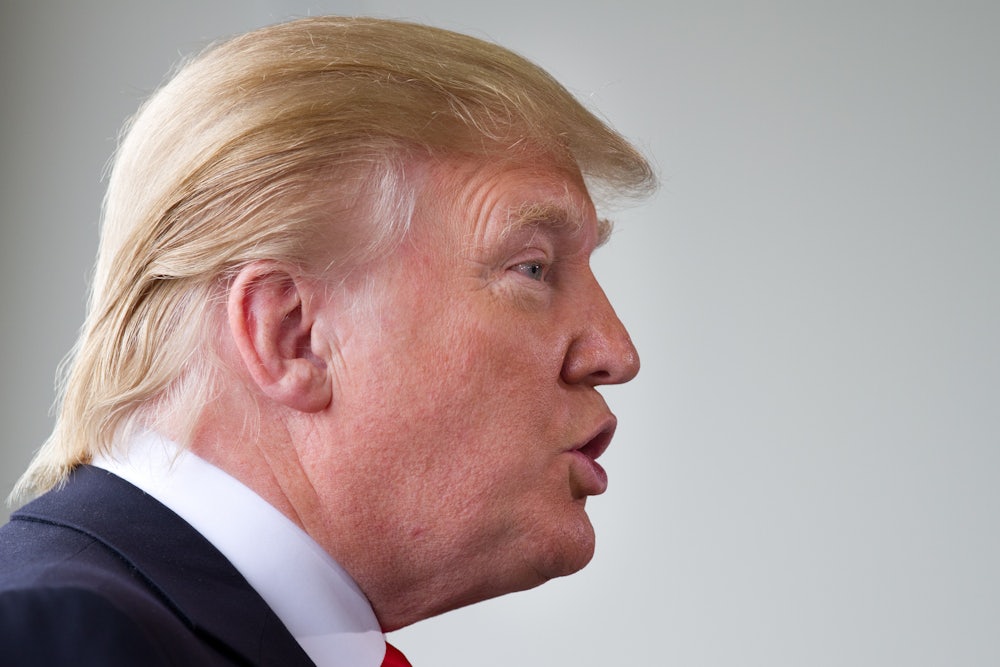Donald Trump becoming the presumptive Republican nominee is such a sui generis event that it’s hard to know what to make of it. He seems to be a weak general election candidate, but liberals conditioned to expect the worst may start to look for reasons why he’s stronger than he appears. Certainly, Trump’s victory over a deep slate of Republican rivals is evidence that we would be foolish to write him off too quickly. But when all is said and done, the impulse reaction is the correct one: Donald Trump is a very poor general election candidate and a massive underdog to win the keys to the White House.
A qualification should be noted at the outset. It would be wrong to say that Trump is “unelectable.” Given the partisan configuration of the country, it is possible for any major party candidate to win. Both parties start out with enough safe states that they can win under the right conditions. It’s also worth noting that Hillary Clinton’s high unfavorable ratings suggest that she is a weaker candidate than Barack Obama. Against a generic Republican candidate, she could well be at a disadvantage.
So it’s not literally impossible for Trump to win. Still, it would be a big upset—maybe not Leicester City winning the Premier League big, but big.
The fundamental problem for the Republicans is that they’re already at a structural disadvantage in the Electoral College. The last six presidential elections have resulted in four very comfortable Democratic victories, a virtual tie resolved by the Supreme Court, and a narrow win by a wartime Republican incumbent in a decent economy—and George W. Bush was still less than 200,000 votes in Ohio away from a loss. The higher turnouts of presidential elections work against the GOP, and changing demographics are only making the problem worse. Barring economic catastrophe, a poor candidate for the Republicans is like handing an anvil to a mountain climber; they can’t really afford even a modest negative impact.
And the negative effects of Trump might be more than modest. We can start with the fact that outside his core of supporters virtually nobody likes him. Hillary Clinton is given a “very unfavorable” rating by upwards of 40 percent of voters, easily breaking the previous record of a major party nominee set by Bush in 2004. But Trump blows that out of the water; he is viewed very unfavorably by a majority of voters. Admittedly, his unfavorable rating should come down as Republican-leaning voters who didn’t vote for him in the primary start to come around. But the same will be true of Sanders-supporting Democrats when they begin to consider the prospect of a Trump inauguration. Clinton will also have a major asset in appealing to unenthused Democrats—an increasingly popular President Obama campaigning on behalf of his former secretary of state. Trump has already gotten a definitive cold shoulder from the last two Republican presidents.
We can also at least tentatively consider head-to-head polls. As Princeton’s Sam Wang explains, general election matchup polls start to have some predictive value as early as February. (Every election is different, but given how long Hillary Clinton and Donald Trump have been public figures, these polls could, if anything, be a more reliable indicator of future results than usual.) And this is excellent news for Democrats. The average poll gives Clinton a 6.5-point edge. Based on past historical trends, Wang estimates that “the probability that Trump can catch up by November is 9 percent, and the probability that Clinton will remain ahead of Trump is 91 percent.” A one-in-ten chance of a President Trump is still a little scary, but Democrats have to like those odds.
Still, while head-to-head polls have some predictive value, it’s important to be careful about overstating their importance. After all, some polls have indicated that Clinton is leading Trump in Utah. More than the polls, it’s the electoral map that makes it difficult to see Trump prevailing.
Let’s start with one state: Florida. It is enormously difficult to see any path for Republican victory that doesn’t include the Sunshine State. But it is very difficult to see Trump, who is likely to both mobilize a higher-than-usual minority turnout and fare even worse among such voters than Mitt Romney, winning a state that was roughly 40 percent African-American and Hispanic as of the 2010 Census—a percentage that is almost certainly higher in 2016. For what it’s worth, the early polling shows Clinton clobbering Trump in Florida.
Trump’s weakness with minority voters and educated professionals will also mean that he’s nearly drawing dead in increasingly blue Virginia, and he may well be an underdog in North Carolina as well. Losing all three states would essentially foreclose a Republican win.
Even assuming that Clinton merely holds Florida and Virginia, it’s not clear how Trump can win. He would have to have unusual success in the upper Midwest, but this is probably Republican wishful thinking.
If Trump loses Florida and Virginia, even winning Ohio, Wisconsin, and Pennsylvania wouldn’t put him over the top. Adding Michigan would do it, but contrary to some assumptions, Michigan is not a swing state. Obama won it in 2012 by nearly 10 points against a quasi-native son Republican candidate, and that was in much worse economic circumstances and before Governor Rick Snyder drowned his party’s brand in the Flint River. Trump is not going to carry it. You would also have to be an extremely optimistic Republican to think Trump could capture the relatively diverse and urban state of Pennsylvania for the GOP for the first time since a much more moderate Republican carried it by less than two points in a landslide election in 1988.
After 2012, many Republicans were aware that the country’s demographics were tilting against them in presidential elections. Nominating Donald Trump perversely exacerbates these problems rather than alleviating them. This doesn’t guarantee a win for Hillary Clinton, but it does make it overwhelmingly likely.
